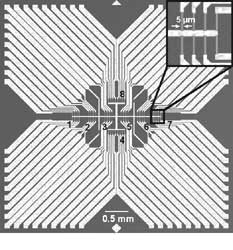BARC: A Magnetoresistive Biosensor
Paul Sheehana, Rebecca Edelsteinb, Cy Tamanahaa, Michael Millera, Li Zhongb, Lloyd Whitmana, Richard Colton*, a
aNaval Research Laboratory,
Washington, DC 20375-5342 USA
bGeo-Center, Inc.
This is an abstract
for a presentation given at the
Eighth
Foresight Conference on Molecular Nanotechnology.
There will be a link from here to the full article when it is
available on the web.
The Bead ARray Counter (BARC) is a revolutionary biosensor that uses DNA microarrays, magnetic microbeads, and giant magnetoresistive (GMR) magnetic field sensors to detect and identify biological molecules [1,2]. Because each GMR sensor is capable of detecting a single magnetic bead, the BARC biosensor should be capable of detecting a single molecule. With recent advances in GMR technology for computer memory, chips with millions of sensors will soon be commercially available, enabling the development of a BARC sensor capable of detecting thousands of analytes simultaneously. The current prototype is a tabletop instrument with integrated fluidics under development for the detection of biological warfare agents [2]. The core of the sensor is a small, microfabricated chip shown in Figure 1 containing a GMR sensor array for detection of up to eight different pathogens. Oligonucleotide probes complementary to pathogen target sequences are arrayed onto the microfabricated chip directly above the GMR sensors. Specific hybridization is measured and discriminated from non-specific background by addition of functionalized magnetic microbeads that bind to the captured target DNA. The GMR sensors detect the beads tethered to the surface, with the intensity and location of the signal indicating the concentration and identity of the target pathogens. A complete assay, including hybridization and detection can be performed in approximately 30 min. We will discuss the scientific and technical challenges to making such a sensor system a reality.
Supported by the Defense Advanced Research Projects Agency.
- D.R. Baselt, G.U Lee, M. Natesan, S.W. Metzger, P.E. Sheehan, and R.J. Colton, "A Biosensor based on magnetoresistance technology," Biosensors & Bioelectronics 13, 731 (1998).
- R.L. Edelstein, C.R. Tamanaha, P.E. Sheehan, M.M. Miller, D.R. Baselt, L.J. Whitman, and R.J. Colton, "The BARC biosensor applied to the detection of biological warfare agents," Biosensors & Bioelectronics 14, 805 (2000).
 |
| Figure 1. Optical micrograph of the prototype 64-element BARC chip showing eight clusters of eight sensors. A DNA probe is spotted above each cluster. Inset: Enlargement of a single cluster of eight GMR sensor strips. |
*Corresponding Address:
Dr. Richard J. Colton, Head Surface Chemistry Branch
Naval Research Laboratory
4555 Overlook Ave., S.W., Code 6170
Washington, DC 20375-5342 USA
Email: [email protected]
Web: http://stm2.nrl.navy.mil
|